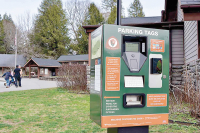Waynesville’s electric system is a cash cow for the town, but can the good fortune continue?
 If Waynesville has a dirty little secret, it’s this: a cash cow runs through its power lines.
If Waynesville has a dirty little secret, it’s this: a cash cow runs through its power lines.
Of course, it’s not dirty and not a secret — not really. Town leaders don’t hide the fact they have a lucrative electric system. It reaps over $1 million in profits annually for the town.
“It is important to the community. The money that has been generated from the electric system built the recreation center, built the parking deck, built the police department and built the new fire department,” Mayor Gavin Brown said.
They’re monuments for all to see that Waynesville is well-heeled for a town its size. But few realize just how much the electric utility props up the town.
It pays for the perks that make Waynesville stand out – amenities that land the town on “Best Of” lists, earn it the title of “progressive,” and score bragging points for quality of life. Ultimately, profits from its power utility fund things the town couldn’t otherwise afford.
“The number I always quote to people is how much higher our tax rate would have to be to still do the same things we do now if it weren’t for the electric system,” said Eddie Caldwell, town finance director.
Related Items
The $1.2 million the town made on electric profits last year are equivalent to a whopping 11 cents on the property tax rate.
The town buys electricity wholesale and resells it at a markup to roughly 3,000 customers on its power grid.
But the wholesale price of power has been getting steeper. The town’s wholesale cost per kilowatt has gone up 50 percent over the past decade.
“That increase is squeezing us,” Brown said.
As the wholesale cost climbs, it’s getting harder to sustain the profits the town has come to rely on. That leaves two options, and they’re equally unpalatable.
One is to keep raising the rate for its own retail customers to maintain the same profit margin despite increasing wholesale costs. But there’s a limit to how much the town wants to charge its own customers.
“The problem is, can you provide power at an economical rate?” Waynesville Utility Director Fred Baker asked.
The other option is keeping power rates low for town customers — but that means sacrificing profits.
“Any profit to be made is put toward things that benefit the community as a whole. If you can’t make a profit off it, why do it?” Baker asked.
That’s a question town leaders have emphasized again and again as they contemplate the looming question ahead: who to buy wholesale electricity from in the future.
“If we can’t make a profit and keep our power bills competitive, we shouldn’t be in the power business,” said Caldwell.
Fork in the power lines
The town is facing a critical juncture with its electric system, one that will decide whether it can sustain its profit margin.
The town’s wholesale power contract with Duke Energy expires at the end of next year. It must now choose whether to stay with Duke or sign on with a different wholesale power provider.
The stakes are huge. If the town chooses well, it will continue to get wholesale power at an affordable rate, and continue making the profits it counts on. If it chooses wrong, it could end up with more expensive wholesale rates, in turn cutting into profits or unduly hiking rates for its customers.
“You are trying to prognosticate and look down the road 10 years from now. This is a new ballgame for the town,” Brown said.
Earlier this year, the town fielded proposals from six power providers and weeded that number to three contenders.
The town initially planned to narrow in on a choice by the end of the year and enter an extensive period of due diligence during 2015 to hammer out the terms of a power contract.
It seemed the town was close to a decision, with a vote by the town board planned in November. But the town abruptly put the brakes on the process for further fact-finding.
“We don’t have enough information to eliminate or select from those three suppliers,” Town Manager Marcy Onieal said. “We felt like we needed to pause to become better versed in the critical issues that may potentially distinguish one proposal from another.”
The town was relying on its long-time energy advisor, Kevin O’Donnell of Nova Energy Consultants, to help vet the three contenders and make a recommendation.
But the pros and cons of the proposals — each with its own share of unpredictable variables — have been more difficult to dissect than initially thought.
There’s an underlying conundrum in all three proposals: the town is unlikely to lock in wholesale power rates as low as it has had in the past, forcing some tough decisions.
“It will be hard to stay close to market retail rates and still do everything the town’s electrical system has historically done,” O’Donnell said. “That is the crux of what we are trying to do.”
None of the proposals guarantee the town a wholesale power rate for the next 10 years — and none are immune from risk.
“These rates have a lot of float in them,” Brown said.
At a town meeting in October, each of the three finalists came before the town board and made its best pitch for why it should be chosen.
• Southern Company, a private power producer with a network of natural gas plants across the South, deals exclusively in natural gas power. The cost of natural gas is low right now, but what if that changes?
• Santee-Cooper, a South Carolina public utility, has a nuclear plant scheduled to come online in a few years. When it does, it would offer the lowest-cost power, but delays and cost overruns in completing the plant could jeopardize that.
• If the town stays with Duke, it would have the safety net and reliability of Duke’s diverse generating portfolio. But fallout from Duke’s coal ash disaster carries a pricey clean-up cost, which would be passed along to the town in the form of higher wholesale rates in the future. Likewise, if regulators crack down on carbon emissions, forcing costly upgrades at Duke’s coal plants, those costs could also be passed along in the town’s wholesale rates.
“We are fighting to keep our rates as close to Duke’s retail rates as possible. Where are your numbers going to be relative to one another five years down the road? Ten years down the road?” O’Donnell said.
The town has brought on a second energy consultant, UTEC Engineers-Consultants, to help analyze the pros and cons and advise in the process.
The firm will also do a technical and operational assessment of the town’s electric system.
“We are taking a brief step back. It is too big a decision to do this either hastily or in a vacuum,” Onieal said.
Testing the current
Waynesville is entering a brave new world as it contemplates who to buy power from. It’s never been an option before.
The town was pigeon-holed into buying power from Progress. They owned the transmission lines leading to the town’s doorstep, so Progress was the only option. Duke bought Progress two years ago, so Duke took over the town’s wholesale power contract.
When that contract expires next year, the town will no longer have to buy its power from the utility baron that owns the lines.
For the first time, Waynesville can buy its power from anyone it wants, and simply pay Duke a fee to move it along the grid to Waynesville’s doorstep.
The trade of wholesale power was deregulated about a decade ago, splitting it into separate commodities. Making the power and moving it where it needs to go — known as power generation and power transmission — could be sold separately.
The “unbundling” of electricity made it possible to buy power from a source several states away.
“It’s becoming more common to wheel power in from another source,” Baker said.
Moving power across someone else’s transmission lines comes at a cost, however. Whoever owns the transmission lines charges a fee to wheel the power from point A to point B across its lines. But it still creates options.
“The market is such now that it is hard to ignore the economics,” Baker said.
But the choice also brings uncertainty. Whether to leave the safety net of the corporate utility giant du jour is a decision other towns with electric systems will face in coming years as well, as their own wholesale power contracts begin to expire. Waynesville is one of the first to face that proposition, however.
“We are just out in front in terms of the timing of the contract, but we are certainly not alone. We are probably the tip of the spear in terms of others that are also going to be looking,” O’Donnell said.
The dreaded monthly true-up
There’s one saving grace as the town stares down the barrel of higher wholesale power rates and the prospect of incremental rate increases for its customers to make up the difference. All electricity customers in the state — including the vast majority on Duke power — will see their power bills go up, too.
Duke Energy adjusts the cost per kilowatt for its own customers every year to mirror the increased cost of power generation.
While the rate for Duke’s customers is only adjusted once a year, the town gets hit monthly.
“They do it to their wholesale customers on a monthly basis,” Caldwell said.
A fluctuating surcharge is tacked on to the base kilowatt rate each month, a cost that mirrors the ebb and flow of power generation costs. The town has no control and no way to predict what the surcharge will be from month to month.
During the polar vortex last January, power was in high demand but supply was limited, so it came at a premium. Waynesville was hit with a $350,000 surcharge on top of the base rate that month.
Caldwell generates monthly spreadsheets of the per-kilowatt cost of wholesale power coming down the pike from Duke. The town in turn adjusts its power rates to recoup the surcharges billed by Duke.
“I have to stay on top of this or things could go south in a hurry, especially when you get hit with that kind of true-up,” Caldwell said, citing whoppers like the January surcharge.
Landlocked
As the town searches for ways to offset the rising cost of wholesale power, one option that’s off the table is expansion.
The 3,000 customers on the town’s grid now are essentially all it will ever have.
“We are a low-growth utility,” Baker said.
Electric utilities have defined territories and lay sole claim to the customers within their boundaries. Today’s boundaries are locked in, holdovers from the pioneer days of electricity. Whoever was first to put up power lines and bring service to an area still lays claim to that territory today.
Waynesville’s power grid once covered the whole town, but that was in the 1940s and 1950s. The town since grew, but the electric service area is limited to its original footprint.
The town’s only chance of adding customers is new construction built inside its existing territory.
But the town’s core — the area served by town power — is already built up. Commercial growth along Russ Avenue and South Main are outside the town’s service area. The new subdivisions and townhomes being built on the town’s perimeter are also outside the town’s electric boundaries.
One growth area the town has seen is cell towers. While there’s just a few cell towers in the town’s electric service territory, more antennas and equipment are being heaped on to the existing towers to handle the growing volume of wireless data. The additional capacity added to the towers use more electricity.
The town has also seen power use increase from one of its major industrial customers, Sonoco Plastics. As for regular customers, despite the addition of computers and electronics that get charged nightly, the average household electricity use has stayed the same through the years.
“You have a lot of people switching to more energy efficient appliances,” Caldwell said. “Residential households haven’t gone up that much.”
Holding the line
While the town agonizes over who to buy power from, in the end, it’s a role of the dice. Who knows what the cost of wholesale power will be two, five or 10 years from now, no matter who the town chooses.
And that’s a frustrating proposition. The electric system is a highly prized asset and critical moneymaker to the town. Yet the town has little control over its revenue potential and will have to succumb to the whims of the marketplace.
There’s one part of the equation the town can control, however: its own operational costs.
For the past decade, the operating costs of the electric department have held steady at $750,000 a year, a budget that includes equipment, supplies and salaries. The electric department has six employees who do it all — tie in new additions to the town’s grid, repair downed lines, fix outages and replace burnt-out streetlights.
But most of the work is preventative. The crews proactively replace power poles, trim trees hanging over the lines and perform routine maintenance on transformers and the two substations.
“An average power pole isn’t going to last forever,” Baker said.
The town’s electric system has 2,500 power poles. Crews replace 90 poles a year — so over a 30-year cycle, all the poles in town will have been replaced. The same with streetlights.
“We don’t want them all to be the same age and all go bad the same year,” Baker said.
The town has taken on the added expense of building a second substation five years ago. The debt on the multi-million project is being paid off out of electric proceeds.
The second substation was a noble effort to provide redundancy in the town’s electrical grid, allowing it to serve the town through one substation if the other has to come off-line for repairs or maintenance.
In a sense, the power system is the town’s baby.
For now, there’s no chance the town will sell off the system and get out of the business.
Besides, “No one has offered to come and buy our system,” Brown said.
Town leaders would go to the mat to keep their coveted prize, as long as it’s working for the town.
“We do make money off this enterprise,” Brown said. “If we didn’t, then there would be no reason to be in the electric system.”
Feeling the squeeze, and passing it on
As wholesale power rates have risen over the past decade, Waynesville has hiked its rates to protect its profits off its electric system, passing along the rising cost of wholesale power to its own customers.
So far, the town has risen its own retail rates enough to keep pace with the higher cost of wholesale power.
But wholesale power prices are expected to rise more sharply over the next 10 years, making it increasingly difficult for the town to maintain the profit margin it has enjoyed in the past to fund the perks and quality of life amenities the town hangs its hat on.
Worth noting: electricity use by town customers has risen only marginally. The increase in wholesale costs and retail billing reflects an increase in the cost per kilowatt hour.
Profits
2004 $1.35 million
2014 $1.2 million
Cost of wholesale power purchased by the town
2004 $3.6 million
2014 $6 million
Retail power sales billed to customers
2004 $6 million
2014 $8.3 million
Kilowatt hours used by town customers
2004 92.7 million
2014 96.3 million
Wholesale cost per kilowatt hour
2004 3.9 cents
2014 6.1 cents
Electrical department operations and overhead
2004 $750,000
2014 $750,000
By the numbers
3,050 customers on Waynesville’s power grid
90 years the town has been in the power business
11 cents on the property tax rate
50 percent increase in the per kilowatt cost of wholesale power for the town
Let there be light
It’s somewhat rare for a town to run its own electric system. Waynesville’s dates to the late 1920s, on the forefront of the rural electrification push of the 1930s.
At the time, electricity was slow to reach the Southern Appalachians. Like the rest of rural America, there weren’t enough customers — or profits — to make it worthwhile for major electric companies to run their lines here.
The only way for a small town to get power back then was to build its own system.
“The hinterlands were getting ignored,” Waynesville Utilities Director Fred Baker said. “The concept behind rural electrification was if we didn’t do it, it wasn’t going to get done. That was the birth of public power.”
Waynesville ran its first lines in the late 1920s. The Rural Electrification Act, easing the way with federal support and assistance, didn’t come along until the 1930s.
Waynesville was ahead of the curve mostly because opportunity came knocking. Carolina Power and Light was building a dam and hydropower plant along the Pigeon River at the time. Waynesville strung power lines across 25 miles of rugged mountain land, nearly to the Tennessee line, to tap the power spigot of Walters Dam.
A checkerboard of stand-alone electric systems harkening back to the rural electrification era remain part of the state’s power landscape today. Only 65 towns and cities in North Carolina — out of more than 500 in all — operate their own electric system. They’re known collectively as “Electricities.”
These towns and cities reap profits off their electric utilities, which is no different than what Duke Energy does. But instead of those profits enriching a corporation, the stockholders, in essence, are all the citizens of the community that collectively benefit,
Waynesville is one of the few public power towns in Western North Carolina, however. There’s only six in the 23 western counties, and of those, four are in the foothills east of Asheville.
• Bostic (Rutherford County)
• Forest City (Rutherford County)
• Morganton (Burke County)
• Murphy (Cherokee County)
• Waynesville (Haywood County)
• Western Carolina University
• Granite Falls (Caldwell County)
*Western Carolina University is also considered an “Electricity,” as the operator of its own utility system on and around campus.









